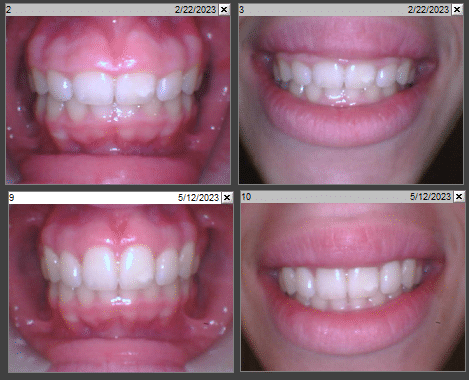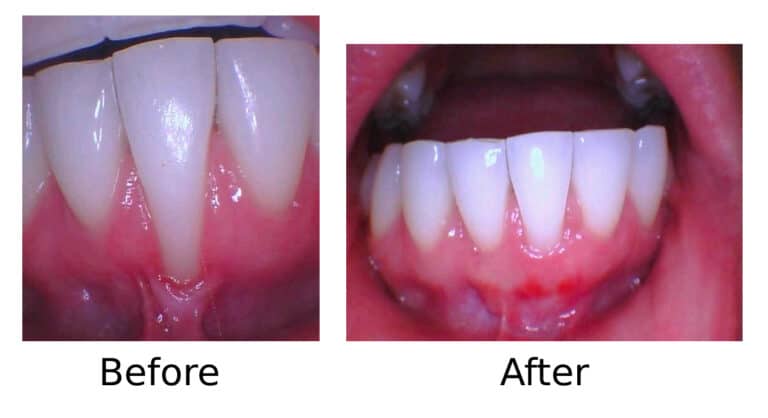A periodontist is a dentist who specializes in the prevention, diagnosis, and treatment of periodontal disease. Periodontists are experts in the latest techniques for diagnosing and treating gum disease. In addition, they can perform cosmetic periodontal procedures to help you achieve the smile you desire. Every patient is different and we customize individual treatment to maximize the benefit to every patient. We provide first-class periodontal treatment in our Spokane, WA office. To learn more, call our team today!
Our team uses many different treatment options to address periodontal disease. Depending on the severity of the disease state, these procedures may be non-surgical or require further intervention including surgical treatment.
Non-Surgical Periodontal Therapy
Our periodontal practice believes that periodontal health should be achieved in the least invasive and most cost-effective manner. This is often accomplished through non-surgical periodontal treatment. Scaling and root planing is a careful cleaning of the root surfaces to remove plaque and calculus (tartar) from periodontal pockets and to smooth the tooth root to remove bacterial toxins. Scaling and root planing, followed by adjunctive therapy, such as direct targeted application of antimicrobials and host modulation (low-dose systemic antibiotics), will be administered as needed on a case-by-case basis. This will be part of the customized treatment for every specific patient.
In an effort to utilize efficient technology, we use ultrasonic scalers for most adult dental cleanings and scaling procedures. These devices use ultrasonic vibrations to help break down the plaque and calculus on the teeth that cause gingivitis and periodontal disease. The ultrasonic cleaners create microscopic bubbles that implode on the surface of the tooth vibrating thousands of times per second, killing microbes and removing plaque and tartar in the process. Our instruments use a thin tip to better navigate the periodontal pockets to help maintain optimal gingival health.
- The procedure only uses water; no chemicals are used.
- It can remove tartar buildup in hard-to-reach areas, with no damage to the tooth enamel.
- Manual scaling often uses pressure for cleaning, while the vibration produced by the scaling tip of an ultrasonic scaler is barely perceptible. This makes ultrasonic cleaning suitable for those with sensitive teeth.
- The cleaning process is faster than manual scaling making your visit more comfortable.
After your teeth have been cleaned with the ultrasonic cleaner, your teeth will be hand scaled to check for any residual deposits and then polished.
Periodontal Surgery
After scaling and root planing, patients will require ongoing maintenance therapy (more frequent cleanings) to sustain oral health. This is incredibly important as gum disease will come back if maintenance is not done.
Non-surgical therapy does have its limitations, however, and when it does not achieve periodontal health, surgery may be indicated to restore periodontal anatomy damaged by bacteria and to facilitate oral hygiene practices.
If after scaling and root planing, your gum disease is not resolved, your doctor may recommend surgery. Periodontal surgery is necessary when the tissues (both soft and hard tissue) around your teeth are still unhealthy and cannot be repaired with non-surgical treatment. Following are the four types of surgical treatments most commonly prescribed:
Osseous Surgery
During the Osseous Surgery procedure (also known as “Pocket Reduction Procedure”), the gum tissue is folded back allowing access to remove the bacteria and deposits of tartar hiding underneath. Removal of any tissue that is too damaged to survive may also occur. The gums are then stitched back into the appropriate locations around the affected teeth. Now that the tooth and root are free of bacteria, plaque, and tartar, and the pockets have been reduced, the gums can reattach to the teeth.
Regenerative Procedures
When the bone and tissue supporting the teeth have been lost due to severe gum disease or loss of a dead tooth, restoration of these areas with a regeneration procedure can be performed. During this process, the gum tissue is shaped allowing access for the removal of the bacteria, plaque, and tartar. Depending on your situation, a bone graft may be performed to stimulate new bone growth, or a special kind of protein that stimulates tissue growth will be placed to repair the areas that have been destroyed by the disease.
Dental Crown Lengthening

Crown lengthening is a surgical procedure performed by a dentist to expose a greater amount of tooth structure for the purpose of subsequently restoring the tooth with a dental crown. This is done by removing some of the tissue and bone from around a tooth. This allows a general dentist adequate space when placing the final crown or veneers.
Connective Tissue Grafting Surgery

A frequent symptom of gum disease is gum recession (also called gingival recession). As the gums recede, more of the roots are revealed. This can make teeth appear longer and can also create sensitivity to hot or cold liquids or food. It also exposes the tooth to increased damage from gum disease, as bacteria, plaque and tartar attack the surface of the root which is more susceptible to damage such as cavities and root abrasion. To repair this problem, a small amount of healthy connective tissue is taken from the underlying tissue of the palate and replaced in the area of recession, covering the roots and restoring the gum line to its original, healthy location. This procedure can also be performed for cosmetic reasons.
Lorem Ipsum
Lorem ipsum dolor sit amet, consectetur adipiscing elit. Morbi sed massa quis felis fermentum tincidunt. In vitae nulla porta, placerat orci eu, imperdiet ipsum. Mauris pellentesque lorem commodo, interdum tortor et, pulvinar tortor. Vivamus a suscipit nulla, at tristique ligula. Aliquam erat volutpat. Proin porttitor turpis eget suscipit maximus.
Mauris vel ligula dolor. Nam convallis elementum commodo. Nulla viverra massa at nisl sollicitudin bibendum nec cursus neque. Etiam lobortis justo diam, porttitor varius lorem dignissim id. Duis vel felis semper, bibendum lectus sed, suscipit leo.


Lorem Ipsum
Lorem ipsum dolor sit amet, consectetur adipiscing elit. Morbi sed massa quis felis fermentum tincidunt. In vitae nulla porta, placerat orci eu, imperdiet ipsum. Mauris pellentesque lorem commodo, interdum tortor et, pulvinar tortor. Vivamus a suscipit nulla, at tristique ligula. Aliquam erat volutpat. Proin porttitor turpis eget suscipit maximus.
Mauris vel ligula dolor. Nam convallis elementum commodo. Nulla viverra massa at nisl sollicitudin bibendum nec cursus neque. Etiam lobortis justo diam, porttitor varius lorem dignissim id. Duis vel felis semper, bibendum lectus sed, suscipit leo.

